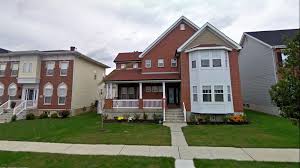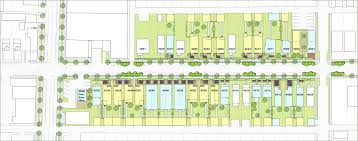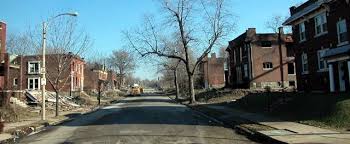In 2004-2005, the City of St. Louis, supported by the Missouri Botanical Garden and the Garden District Commission (GDC), completed the most extensive land clearance project in St. Louis in decades. A practice, thought by many to be a tool of the past was back. In all, six complete blocks of century old brick homes and apartment buildings were leveled for widely spaced 3,400 square foot, $379K, single-family homes on cul-de-sacs.
Perhaps the old McRee Town should not be romanticized too much. Six years after the eastern half of the neighborhood was leveled, the western half has seen very little change. Buildings remain boarded up and shotgun homes can be had for less than $10K. At the time, Michael Allen's Ecology of Absence and Rob Power's Built St. Louis blogs railed against the clear cutting and documented the destruction. St. Louis Commerce Magazine praised the development, correctly noting that gunfire, theft and drugs had become all too common in McRee Town, but clearly going a big step too far by proclaiming of the new development, "Henry Shaw, would no doubt, be pleased.

{a Botanical Heights home}

{rending of 4200 McRee infill by UIC}
Now, a new vision of McRee Town development is being put forward by Brent Crittenden of Urban Improvement Construction (UIC). Brent purchased a building on Tower Grove in 2006, opened his office there in 2007 and finished the upstairs as a home for his family in 2008. If things go well, the 4200 block of McRee will see a mix of modern urban infill and green rehab.

As with Botanical Heights, this effort is supported by the GDC. The organization has consolidated many parcels under one owner, making a more holistic development possible. In this case they have decided against wholesale land clearance. Perhaps they feel that there isn't demand for another Botanical Heights, perhaps land clearance is truly out of fashion and maybe they simply found the right partner in Brent and UIC. For an interview with Brent, check out Park Central's Blog 17.
The long abandoned gas station at McRee and Tower Grove will be converted to a cafe and sales center and two display homes will be built this winter. A charter school may be considering a move to the neighborhood. All together, the project aims for 17 LEED certified historic renovations, 13 new homes and options for GDC owned land could expand the project. Target sales prices range from $120-190K for green rehabs and $190-220K for new 3BR homes.
In addition to the display homes, cafe and sales center, UIC will renovate the facades of all project rehabs on the 4200 block of McRee, giving a a clear vision of what the completed project will look like. More than the scattered, single home efforts of builders like Eco-Urban, this effort should be a better test of the green rehab and modern infill market in St. Louis. While adjacent Forest Park Southeast and the Shaw neighborhoods continue their development, perhaps McRee town can develop as a vibrant neighborhood and further connect the city.


